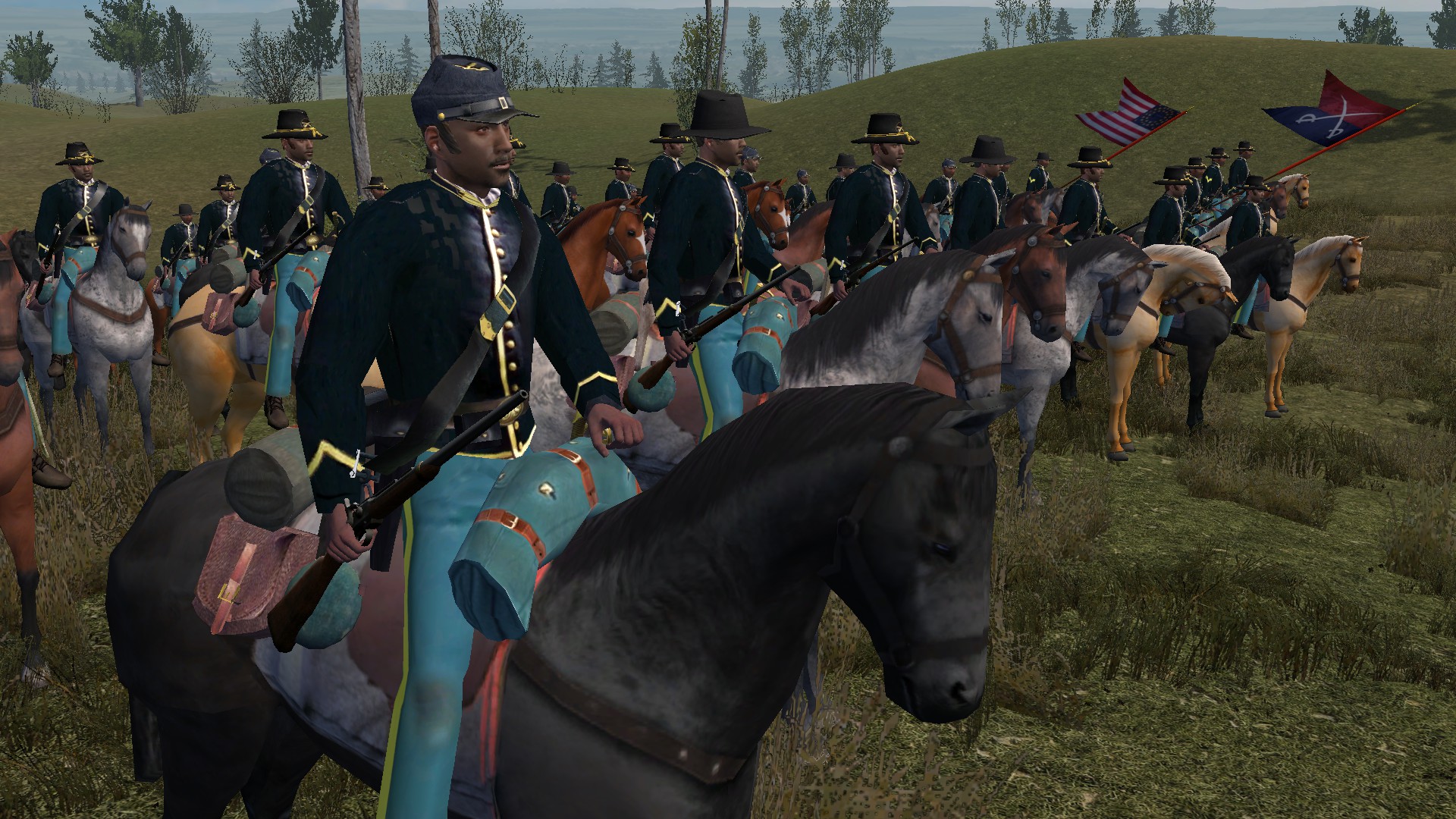Union Cavalry Guide
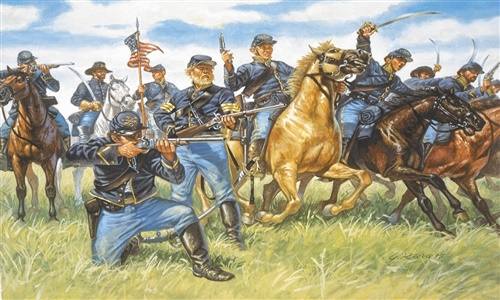
The following is a comprehensive list of all cavalry and mounted infantry units in the mod that are currently available to the Union. This guide is intended to not only show what units are available, but to also give players a quick reference to where those units can be recruited from in the mod, the weapons they are equipped with, as well as which faction and generals they are assigned to.
This guide is organized according to the type of unit, their home state (in alphabetical order), and their designated number (if applicable).
8th Illinois Cavalry
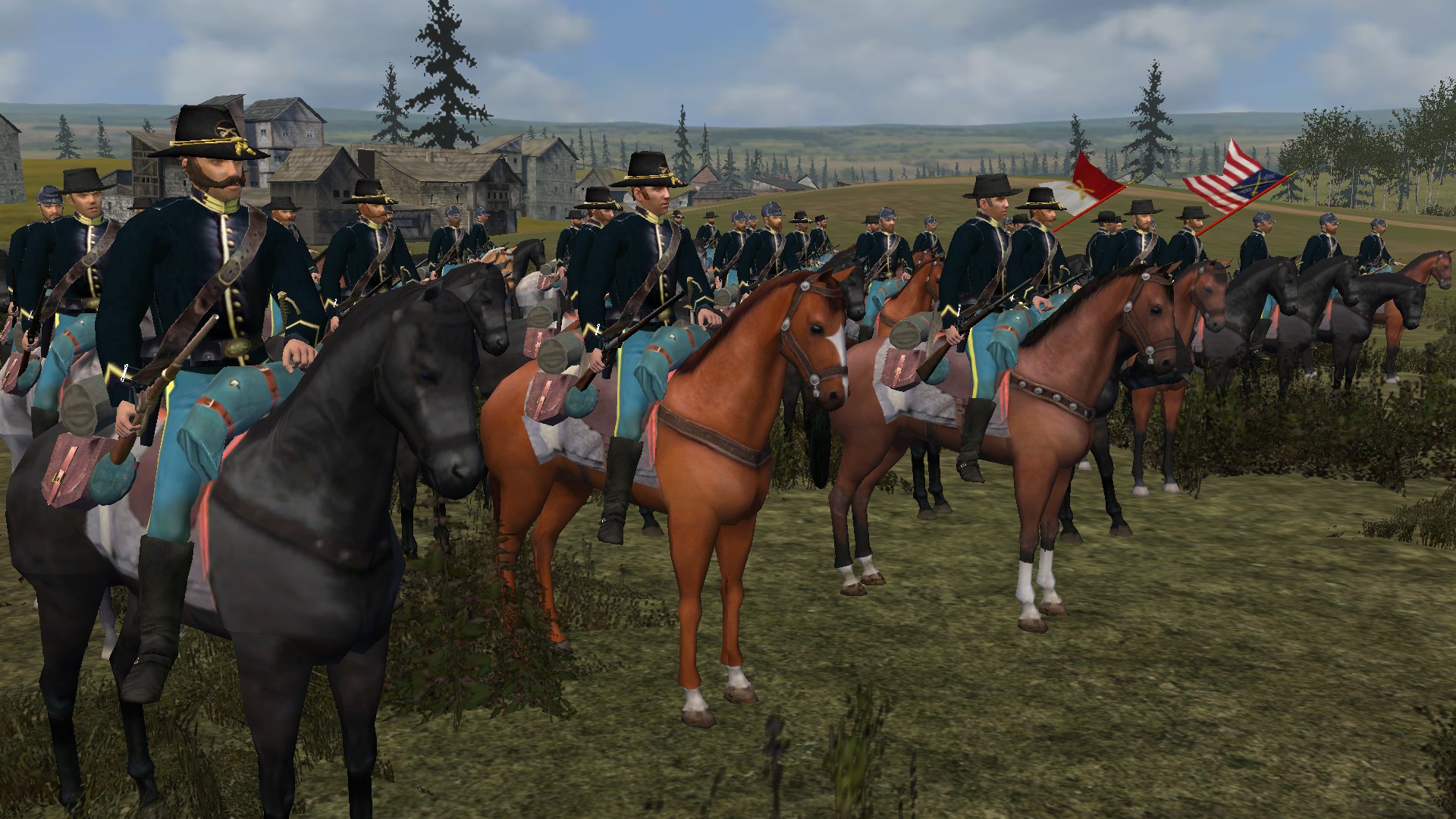
Weapons: M1859 Sharps Carbine, Burnside Carbine, Smith Carbine, Starr Carbine, Sabers
Current Commander: Unassigned (TBA)
Recruitment Locations: Cairo, Chicago, Madison WI, Fort Snelling, Des Moines, Springfield, St. Paul, Marion, Mattoon
The 8th Illinois Cavalry Regiment was commissioned on August 11th, 1861, and was assembled for service in St. Charles, Illinois, on September 18th, 1861, at a site donated by Colonel John F. Farnsworth called Camp Kane. The regiment served for the duration of the war, and was the only Illinois cavalry regiment to serve the entire war in the Army of the Potomac. Lincoln gave them the nickname of "Farnsworth's Abolitionist Regiment" when he watched them march past the White House.
The regiment saw action at Williamsburg, Fair Oaks, Antietam, Fredericksburg, and Brandy Station, the latter engagement being the largest predominantly cavalry engagement of the American Civil War, as well as the largest ever to take place on American soil. During the Gettysburg Campaign, the 8th Illinois Cavalry was in the division of Brigadier General John Buford. Under the command of Colonel William Gamble, they deployed west of Gettysburg on June 30th, 1863, and waited for the oncoming Confederates that arrived early the following morning. The first shot of the battle of Gettysburg is credited to Lieutenant Marcellus E. Jones of the 8th Illinois' Company E, who borrowed a carbine from Sergeant Levi Shafer and fired at an unidentified officer on a gray horse over a half-mile away. The 8th, along with the rest of the brigade, performed a fighting withdrawal towards McPherson's Ridge, delaying the Confederate division of Henry Heth for several hours and allowing time for the Union I Corps to arrive.
The regiment suffered a total of 250 fatalities over the course of the war; 7 officers and 68 enlisted men were killed in action or died of their wounds, and one officer and 174 enlisted men died of disease. After the assassination of President Abraham Lincoln, the 8th Illinois served as President Lincoln's honor guard while he lay in state under the rotunda, and also aided in the hunt for the assassin, John Wilkes Booth.
Michigan Cavalry Brigade "Wolverines"
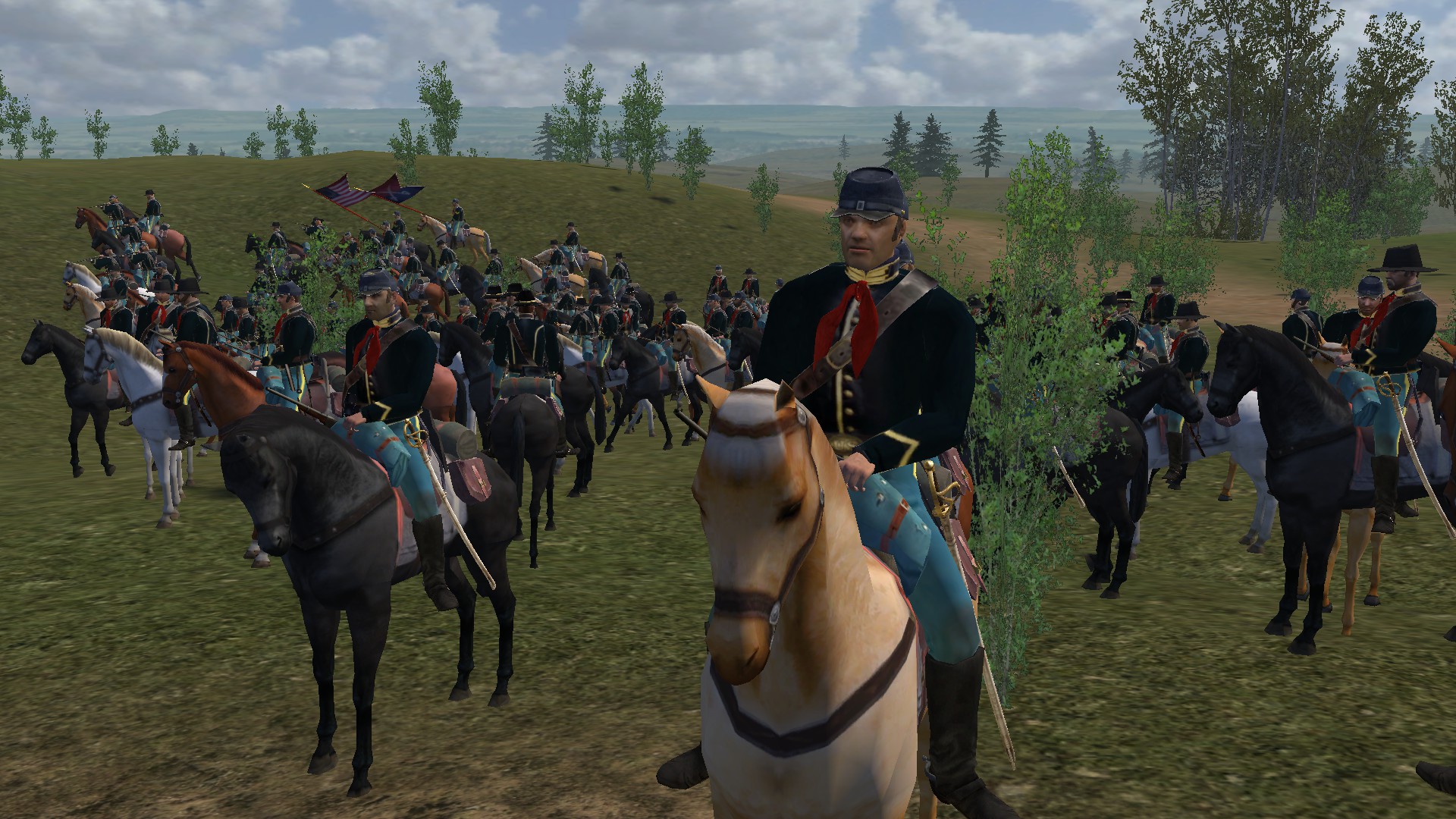
Weapons: M1859 Sharps Carbine, Smith Carbine, Burnside Carbine, Spencer Repeating Carbine, Sabers
Faction: Army of the Potomac
Current Commander: Brigadier General George A. Custer
Recruitment Locations: Detroit, Fort Wayne, Grand Rapids, Toledo, Fremont, Huntington, Camp Randall, Terre Haut, Champaign, De Pere, Lansing, Kalamazoo
The Michigan Brigade, sometimes called the "Wolverines", the "Michigan Cavalry Brigade" or "Custer's Brigade", was created on December 12th, 1862, at Washington, D.C. and composed primarily of the 1st Michigan Cavalry, 5th Michigan Cavalry, 6th Michigan Cavalry and 7th Michigan Cavalry regiments. The Michigan Brigade fought in every major campaign of the Army of the Potomac from the Battle of Gettysburg in July 1863 to the Confederate surrender at Appomattox Court House in April 1865.
The brigade first gained fame during the Gettysburg Campaign under the command of a young Brigadier General George Armstrong Custer. They were posted east of Gettysburg along the Hanover Road on July 3rd, and fought in piecemeal fashion, with the 5th and 6th Michigan Cavalry serving as dismounted skirmishers near the John Rummel farm on the left of the battlefield, while first the 7th and then the 1st Michigan charged into a growing mounted melee in the center. Leading his men in the charge, Custer's cry of, "Come on, you Wolverines!", became the rallying cry of the brigade.
During the retreat of the Army of Northern Virginia from Gettysburg, Custer's men maintained a series of skirmishes and encounters with the Confederate rear guard, fighting another battle at Falling Waters as the last of Robert E. Lee's army slipped across the Potomac River. The brigade continued skirmishing with the Confederates well into Virginia, and again engaged in a series of fights with J.E.B. Stuart's cavalry during the Bristoe Campaign and the subsequent Mine Run Campaign.
In February 1864, the Michigan Brigade participated in Judson Kilpatrick's large 5,000-man cavalry raid on Richmond. Kilpatrick's men severed all the rail lines between Richmond and the Army of Northern Virginia, but did not enter Richmond or free the prisoners, as they had originally intended. During the Overland Campaign in May, the Michigan men were engaged at the Battle of Haw's Shop on the 28th. Some of the relatively inexperienced Confederate South Carolina infantry mistook a Union shift in position for a retreat and charged after them, only to run into Custer's dismounted cavalry who were deployed in a long, double-ranked line of battle, as if they were infantry. 80 Confederates were captured, at a cost of 41 Michigan cavalrymen who fell in the attack, however the Michigan Brigade's enthusiastic charge caused the Confederates to withdraw.
At Trevilian Station on June 11th and 12th, the brigade was heavily engaged, nearly being surrounded, forcing Custer and his men to fight their way out of the encirclement. The Michigan Brigade was engaged at Winchester, Virginia, on August 11th, as well as in numerous other small engagements through September. At the Battle of Opequon, also near Winchester, the brigade captured three Confederate battle flags. They were again in action at the Battle of Fisher's Hill, and on September 26th, Custer was promoted to divisional command. Colonel James H. Kidd of the 6th Michigan assumed direct command of the Michigan Brigade, and the brigade spent the rest of the year in the Valley, engaging in a series of running fights with Confederate cavalry, including the decisive victory over Jubal Early at the Battle of Cedar Creek.
The Michigan Brigade arrived in the Richmond area in time to participate in some of the final engagements of the Army of the Potomac, including the Battle of Five Forks on April 1st. They were active in the pursuit of Lee's retreating army following the fall of Richmond and again engaged the Confederates at the Battle of Sayler's Creek on April 6th. They were among the troops that finally blocked Lee's planned escape route, precipitating the surrender of the Army of Northern Virginia at Appomattox Court House. After the surrender of Joseph E. Johnston, the Michigan Brigade returned to Washington, D.C., for the Grand Review of the Armies on May 23rd.
After the war, several former members of the Michigan Brigade joined the 7th U.S. Cavalry Regiment and later fought again under Custer on the western frontier, and finally at the Battle of Little Big Horn.
2nd Missouri Cavalry "Merrill's Horse"
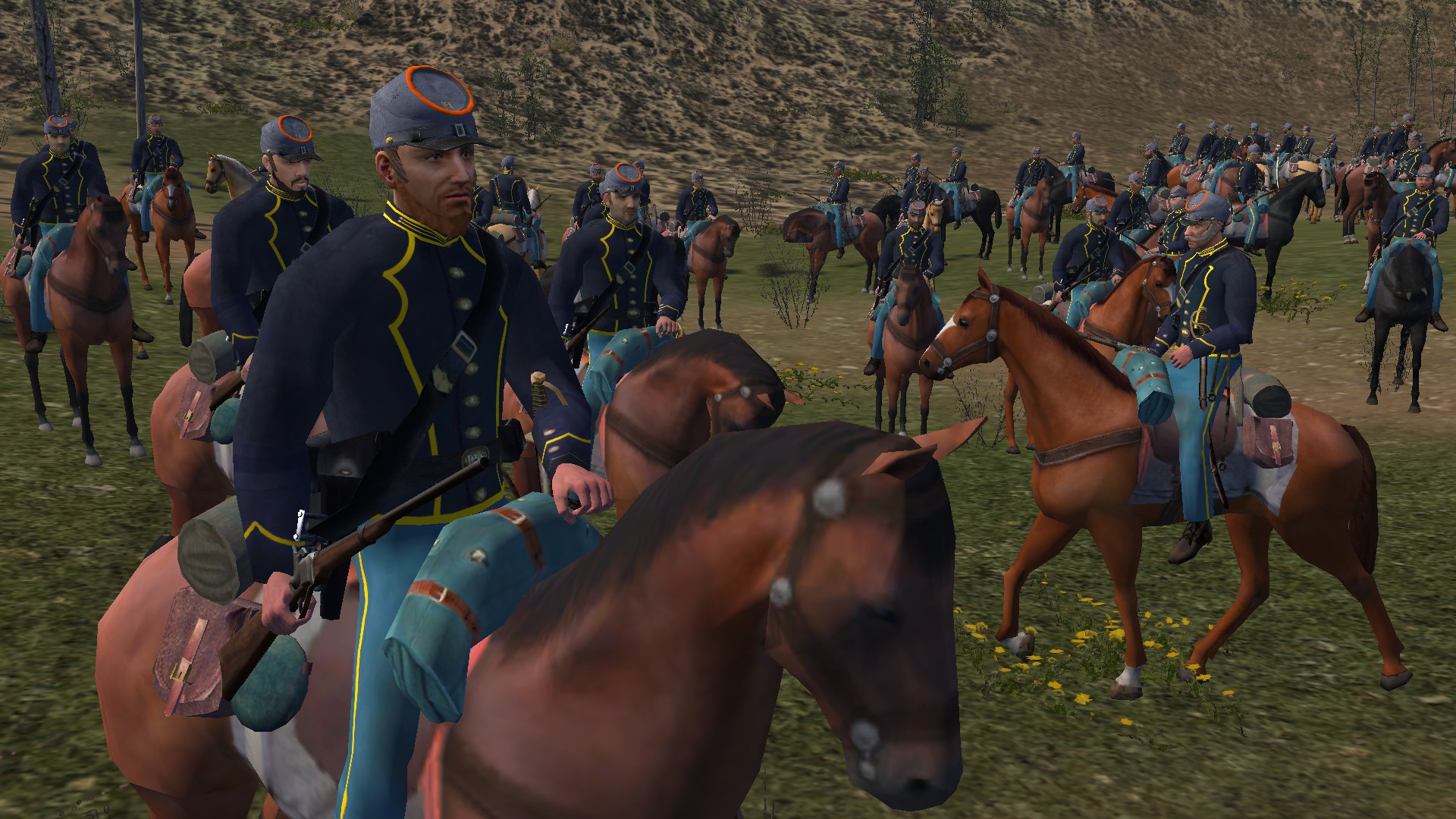
Weapons: M1859 Sharps Carbine, Burnside Carbine, M1819 Hall Rifle, Sabers
Faction: Army of the Mississippi
Current Commander: Major General Philip H. Sheridan
Recruitment Locations: St. Louis, Lexington MO, Carbondale, Vandalia, Union City, Collinsville, New Madrid, Prairie du Rocher, Jefferson City, Mount Vernon, Effingham
One of only a handful of Missouri regiments to be officially named as well as numbered, the 2nd Missouri Cavalry Regiment, also known officially as Merrill's Horse, was raised under the authority of Major General John C. Frémont, and organized by Captain Lewis Merrill, a regular Army officer and a veteran of the pre-war U.S. 2nd Dragoons. Serving as a colonel of volunteers, Merrill organized companies of volunteers from Missouri and other western states at Benton Barracks in St. Louis. Merrill enforced a level of discipline unusual for volunteer regiments, demanding a level of professionalism comparable to U.S. Regulars.
To distinguish the troops of his regiment, Merrill mandated a unique uniform. The front of the tunic featured a "horse-head" panel trimmed in cavalry yellow. The mandated cap was similarly unique: a sky-blue forage cap, with an orange welt (the branch color of pre-war Dragoon regiments) in honor of Merrill's service in the 2nd Dragoons. As with other areas of military discipline, Merrill allowed no deviation from his orders to his troopers in concerning their military appearance: "all additions to or alterations of this uniform as prescribed are positively prohibited and will not be tolerated under any circumstances."
Through most of 1862, Merrill's Horse was assigned the difficult mission of fighting guerrillas and irregular Confederate cavalry in north Missouri. Often operating with Federal Missouri State Militia cavalry, the regiment established a reputation of extreme aggressiveness and effectiveness in the counter-guerrilla mission. Later in the war Merrill's Horse would provide distinguished service in more conventional cavalry missions against regular Confederate units. However, in Arkansas, Tennessee, Georgia, and Alabama the regiment was repeatedly called on to return to the difficult specialist counterinsurgency mission of guerrilla fighting.
The regiment is unusual in that it has two official designations. It was officially raised as "Merrill's Horse", and is usually referred to by that designation in period U.S. Army Records. However, after General Fremont was replaced as commander of the Western Department by Major General Henry Halleck received a second official designation at the 2nd Missouri Volunteer Cavalry. However, in almost all contemporary reports and records the regiment continued to be referred to as Merrill's Horse.
During their service in the war, the regiment lost a total of 262 men: 3 officers and 53 enlisted men were killed in action or mortally wounded, and one Officer and 205 Enlisted men died from disease.
3rd New Jersey Cavalry "Butterfly Hussars"
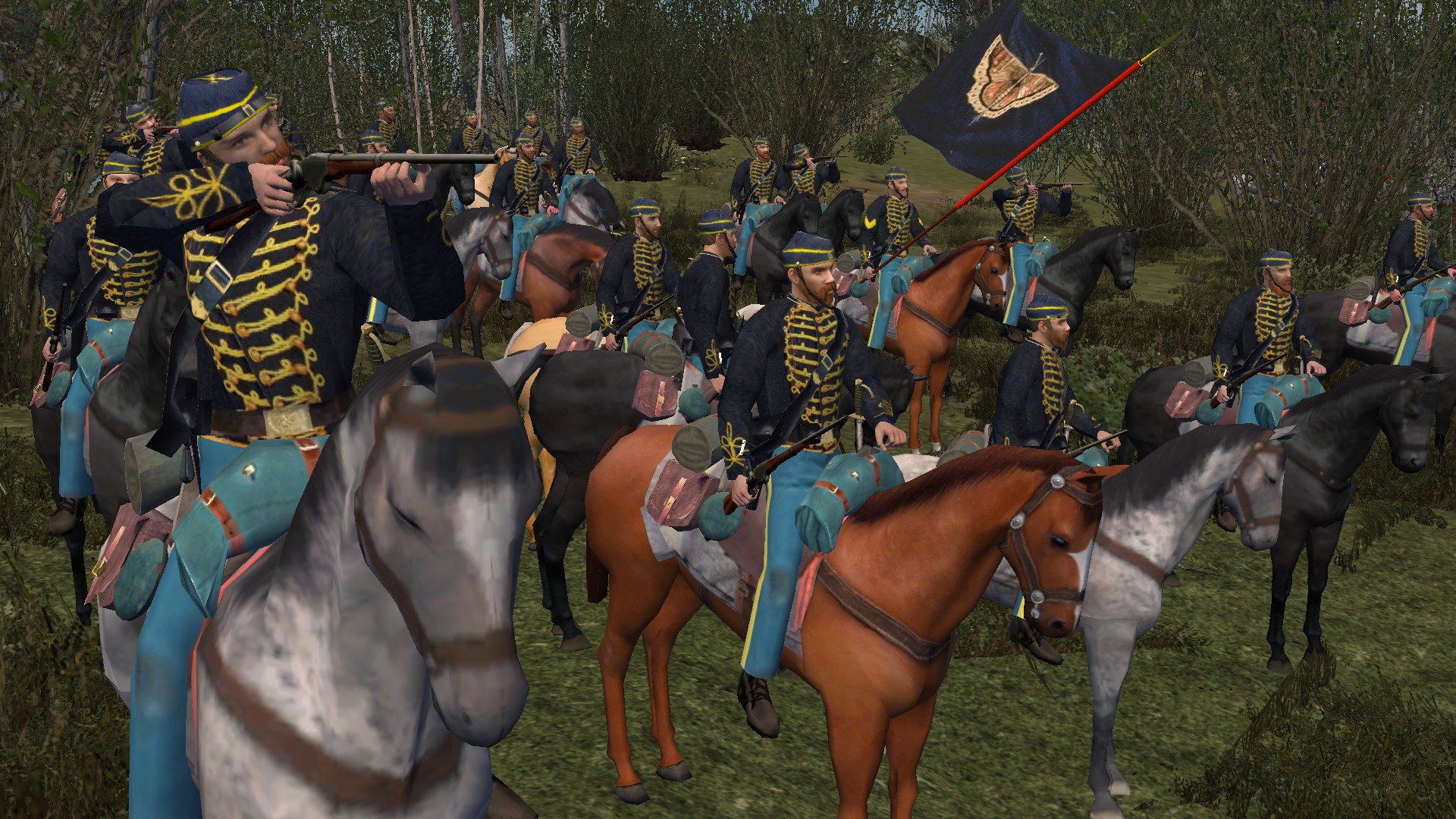
Weapons: Spencer Repeating Carbine, Sabers
Faction: Army of the Cumberland
Current Commander: Brigadier General John G. Parke
Recruitment Locations: Monticello, Trenton, Newark, Princeton, Millville
The 3rd New Jersey Cavalry Regiment was organized at Camp Bayard in Trenton, New Jersey, recruited during the winter of 1863-64, and was mustered into United States service on February 10th, 1864, under the command of Colonel Andrew J. Morrison. The unit is an intriguing one that featured an ethnic mix of predominately German and Irish immigrants, as well as soldiers from more than a half dozen other European countries. They were also known by several nicknames, such as the "First American Hussars", as well as the "Butterfly Boys" and the "Fighting Butterflies"; their creation by an alcoholic ex-officer of the Union Army was supposed to entice men to join a galloping, dashing, romantic cavalry unit, with a unique uniform based on the elegant hussars of Europe that included a hood and cape, and carrying a flag into battle that featured a butterfly.
The 3rd New Jersey Cavalry left Trenton on March 29th, 1864, 1,200 strong, marching by way of Philadelphia and Wilmington to Perryville in Maryland, where it embarked on steamers and proceeded to Annapolis, being there attached to the IX Corps. The enemy being gradually compelled to fall back before the operations of General Ulysses S. Grant, the regiment pushed forward with its brigade, sharing in the operations at Ashland, Old Church and other points, and showing the highest soldierly qualities in all the actions in which it participated. Up to the middle of July, its total losses in killed, wounded and missing amounted to 76. On July 16th, the 3rd New Jersey was transferred to Lighthouse Point, but on the 25th it returned to its old position, and two days later lost several men from guerrillas while on picket duty, one man being killed, two wounded and two captured. At the Battle of Winchester its total loss was 130 men, the killed including one captain and one lieutenant. In the operations at Summit Point the regiment lost six killed, 25 wounded and 14 missing. At Kearneysville its loss in wounded and missing was 30 men, and in the affair on the Berryville Turnpike in September its loss was one killed. After this, the regiment lay quiet until the 19th, when it participated in the Battle of the Opequan, suffering some losses, but not sufficient to disturb their elation over the grand achievements of the day.
It was again engaged at Front Royal, losing some men, and on the 28th, being in the cavalry advance, it once more encountered the enemy at Waynesboro, where it suffered a loss of 10 men killed and wounded, but fought with its accustomed gallantry. In the retrograde movement which followed, a movement designed to draw the enemy once more within effective striking distance, the regiment again proved its efficiency at Bridgewater, losing 9 men; at Brock's Gap, and at Tom's Brook, where it had a severe engagement with the now pursuing foe, its loss in that action being 8 men. Finally reaching Cedar creek, it went on picket, where it remained until the 13th, when it had a sharp fight, losing 10 men. In the memorable Battle of Cedar Creek it was early placed in position, but was only moderately engaged. In the subsequent operations in the Valley it had an honorable part, being engaged on the Back Road and at Mount Jackson, the loss of the command in the latter engagement being 10 men killed and wounded.
In the spring of 1865, the 3rd New Jersey was variously engaged in the vicinity of Petersburg until the last grand assault upon the Confederates. During the Battle of Five Forks, fighting again with the scarred veterans who had swept Early from the Shenandoah Valley, the regiment displayed conspicuous gallantry, sharing in all the perils as well as the splendid achievements of that day, on which the power of the Confederacy was finally and forever broken. The loss to the regiment was only 8 wounded, including Lieutenant Colonel Robeson. Joining in the pursuit of the fleeing Confederates, the regiment lost two officers wounded in a skirmish on the 6th, but was not again heavily engaged. In due time Robert E. Lee surrendered and the Confederate armies dissolved. The regiment proceeded to Washington and participated in the Grand Review, and was mustered out of service on August 1st, 1865. The total strength of the regiment was 2,234, and it lost during its term of service by resignation 17, by discharge 83, by promotion 47, by transfer 276, by death 145, by desertion 439, by dismissal 8, not accounted for 187, and mustered out 1,032.
2nd Ohio Cavalry
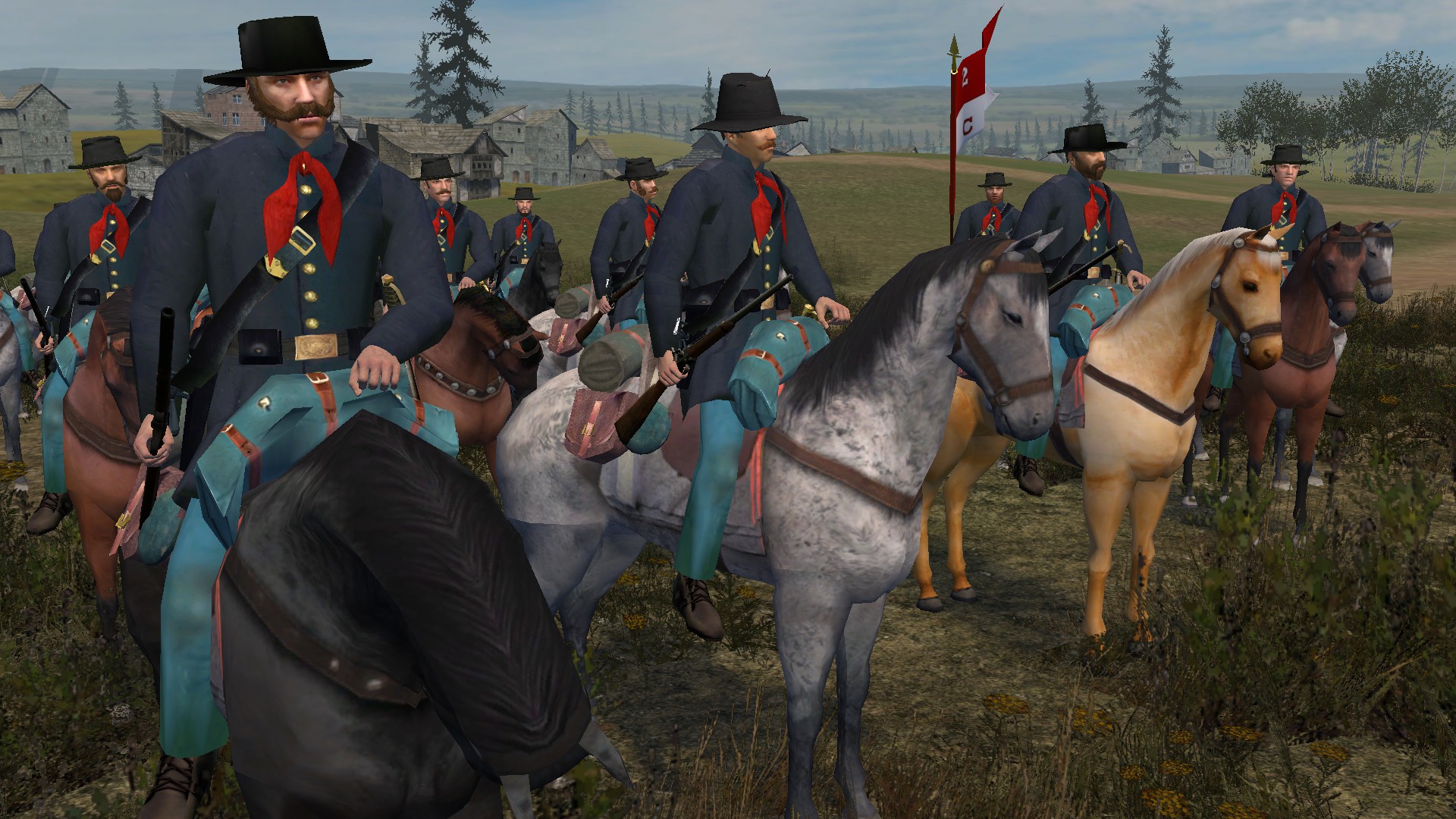
Weapons: M1859 Sharps Carbine, Burnside Carbine, Smith Carbine, Sabers
Upgrades to: Spencer Repeating Carbine, Sabers
Faction: Army of the Cumberland
Current Commander: Brigadier General George Stoneman
Recruitment Locations: Columbus, Cleveland, Cincinnati, Salineville, Mount Sterling, Wheeling, Parkersburg, Jackson OH, New Wilmington, Findlay
On October 10th, 1861, the 2nd Regiment Ohio Volunteer Cavalry completed muster into service at Camp Wade, near Cleveland, Ohio, under the command of Colonel Charles Doubleday. Benjamin F. Wade and John Hutchins organized the regiment, with most of its members coming from the Western Reserve section of Ohio. The 2nd served in nearly every theater of the war, from Indian Territory to Tennessee to Virginia. The 2nd Ohio Cavalry made one of the most brilliant records of any regiment in the service, and six of it's members were awarded the Medal of Honor.
The regiment first moved to Missouri, scouting on the borders of Kansas, and in February 1862, drove the infamous William Quantrill from the town of Independence. In the summer it served in the Indian Territory, and in the fall joined General Blunt's campaign in Arkansas and Missouri, fighting at Pea Ridge, Carthage and other points. It then moved to Kentucky, and four companies raided East Tennessee. It joined in the pursuit of John Morgan and followed him 1,200 miles until he was captured. In September, the regiment again raided East Tennessee and operated on Confederate Lieutenant General James Longstreet's flank at Knoxville, fighting continuously with severe loss.
In April 1864, it was transferred to the Potomac and moved with Grant's army towards Richmond, fighting with Sheridan's Cavalry Corps around the flanks of the army. In August it moved to the Shenandoah Valley and engaged Confederate Lieutenant General Jubal A. Early, fighting at Opequan, Front Royal, and Cedar Creek. In March, 1865, it joined in the pursuit of Robert E. Lee and after the surrender of Lee's army, the regiment was reviewed at Washington and mustered out on September 11th, 1865.
During the 2nd Ohio's term of service, 83 men, including 7 officers, died from wounds received on the battlefield. An additional 184 men, including five officers, died from disease or accidents.
6th Pennsylvania Cavalry "Rush's Lancers"
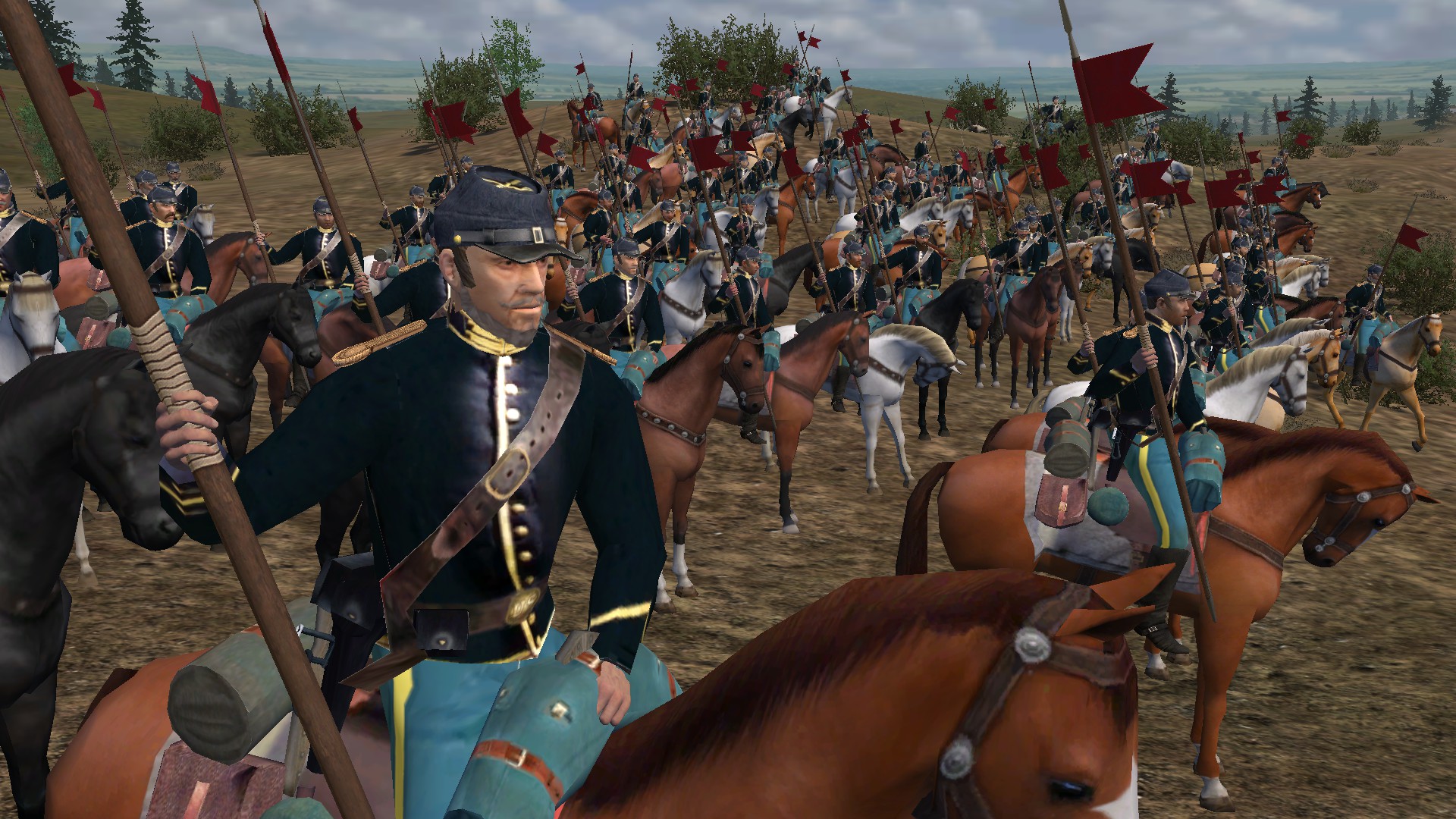
Weapons: Lances
Upgrades to: M1859 Sharps Carbine, Sabers
Current Commander: Unassigned (TBA)
Recruitment Locations: Philadelphia, Harrisburg, Reading, Pittsburgh, Williamsport, Baden, Dubois, New Castle, Allentown, Montoursville, Dover, Lancaster, Elkton, Chambersburg
The 6th Pennsylvania Cavalry Regiment was raised during August and September 1861 from companies raised in Philadelphia, Montgomery and Berks counties by Richard H. Rush, who had been authorized to do so by Governor Andrew G. Curtin. They were known for their early use of lances, and were called "Rush's Lancers." The regiment received their lances on November 30th, 1861, and after several weeks of training in Philadelphia, the regiment was transferred to Washington, D.C., where it was assigned to the Cavalry Division of the Army of the Potomac.
The regiment served with the army during the Peninsula Campaign and Maryland Campaign, skirmishing many times but seeing no heavy fighting. It was absent during the Battle of Chancellorsville, instead participating in Stoneman's Raid. In May 1863, the regiment retired their lances and were rearmed with Sharps carbines. They were assigned to the Reserve Brigade of the 1st Cavalry Division and fought in both the Gettysburg Campaign and Mine Run Campaign. During the Battle of Brandy Station in June 1863, the regiment (led by Major Robert Morris, Jr.) unsuccessfully charged the guns at St. James Church, suffering the greatest casualties of any regiment in the battle. Several Confederates later described the 6th's charge as the most "brilliant and glorious" cavalry charge of the war.
The following year, it fought in the Overland Campaign and with Sheridan in the Valley Campaigns of 1864. In September, the regiment's original enlistments expired, and the unit was reorganized for an additional three years. Following the Appomattox Campaign, it was ordered to Washington, D.C., where it was consolidated with the 1st Pennsylvania Cavalry and 17th Pennsylvania Cavalry to form the 2nd Pennsylvania Provisional Cavalry. The combined regiment was sent to Louisville, Kentucky, where it was mustered out in August 1865.
The 6th Pennsylvania Cavalry had one Medal of Honor Recipient: Captain Frank Furness, commander of Company F. According to the citation for the medal, awarded after the war on October 20th, 1899, during the Battle of Trevillian Station, Furness "Voluntarily carried a box of ammunition across an open space swept by the enemy's fire to the relief of an outpost whose ammunition had become almost exhausted, but which was thus enabled to hold its important position."
1st U.S. Cavalry
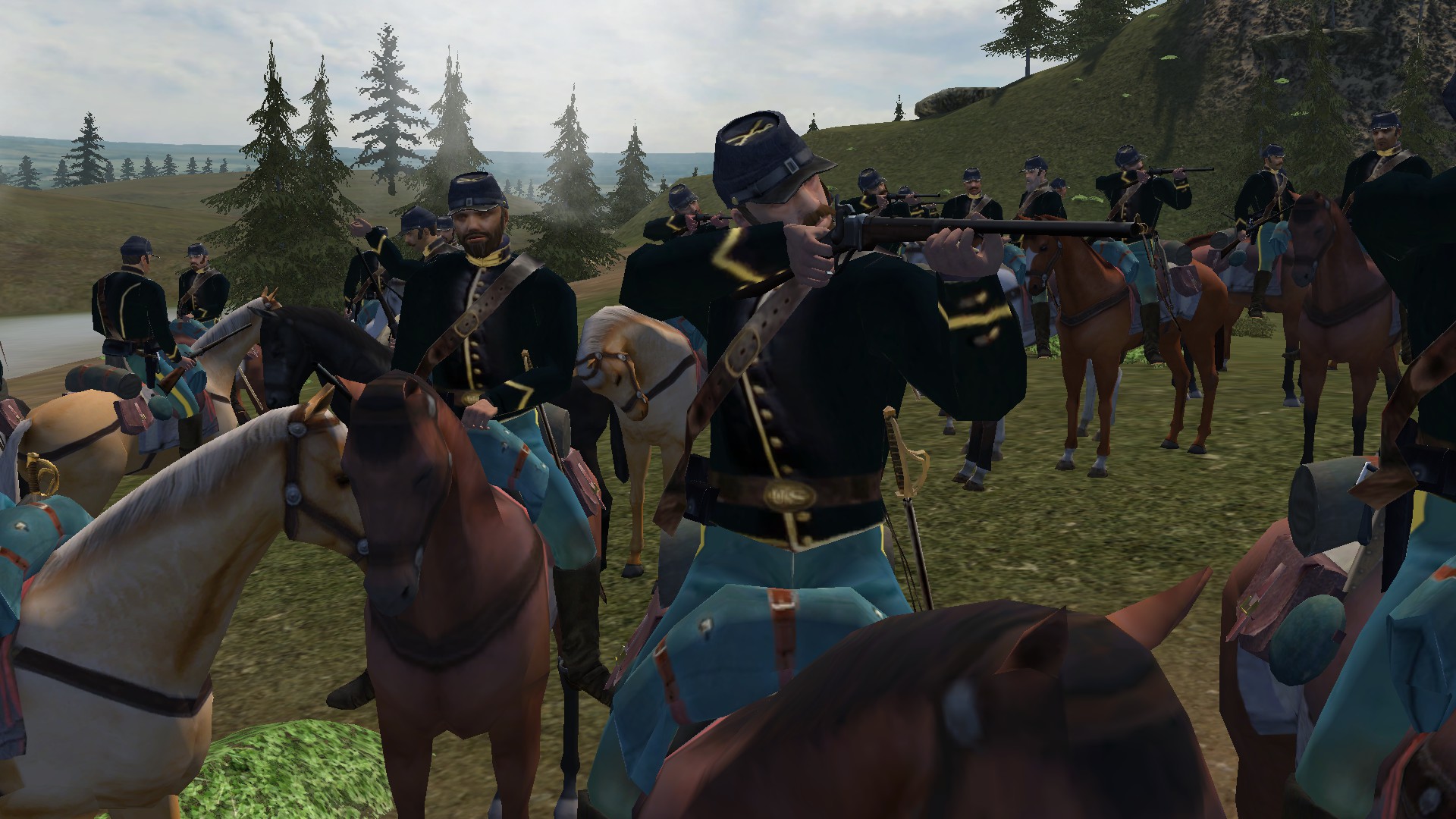
Weapons: M1859 Sharps Carbine, Burnside Carbine, Sabers
Faction: Army of the Potomac
Current Commander: Brigadier General John Buford
Recruitment Locations: Washington, Baltimore, Sharpsburg, Montpelier, Monocacy, New London, Portsmouth, Concord, Hartford, Portland, Harpers Ferry, Frederick, Alexandria, Burlington
The 1st Cavalry Regiment has its antecedents in the early 19th century in the formation of the United States Regiment of Dragoons. To this day, the unit's special designation is "First Regiment of Dragoons". With the outbreak of the Civil War and the War Department's wanting to re-designate all mounted regiments as cavalry, and to renumber them in order of seniority, the First Dragoons became the "First Regiment of Cavalry" by an Act of Congress on August 3rd, 1861.
While Companies D and G remained in the New Mexico territory and participated in several engagements, the bulk of the 1st U.S. Cavalry, fought in the Peninsula Campaign in Virginia. At Williamsburg on May 4th, a squadron under Captain Benjamin F. "Grimes" Davis charged and repulsed Confederate cavalry, capturing a flag but losing 13 men. At Gaines' Mill on June 27th, the regiment lost 26 more men. The regiment participated in fighting at Malvern Hill, Kelly's Ford, and during Stoneman's Raid in April and May. At the battle of Beverly Ford in June 1863, Captain Davis was killed while in command of the 8th New York Cavalry. At Upperville, the 1st U.S. Cavalry met the Jeff Davis Legion and the 1st and 2nd North Carolina regiments in a mounted charge, where the regiment lost 53 men (most to saber cuts). Another 16 men were lost at Gettysburg, and several more were lost in a series of skirmishes during the Confederate retreat to Virginia.
After a period of rest and re-equipping near Washington, D.C., the 1st Cavalry rejoined the Army of the Potomac and was engaged at Manassas Junction, Catlett's Station, Culpeper, Stephensburg, and Mine River. In February, the regiment engaged in a series of fights along the Rapidan line, and then accompanied Brigadier General George Armstrong Custer in a raid on Charlottesville, Virginia. The regiment took part in the battles of Todd's Tavern on May 7th, and Spotsylvania Court House on the 8th. The regiment subsequently accompanied Sheridan on his daring raid around Richmond, fighting in multiple engagements. At the Battle of Cold Harbor, the regiment saw severe fighting, losing several men and officers. The 1st Cavalry then lost 35 men in the Battle of Trevilian Station, and was engaged in daily skirmishing during the return march to White House Landing, where they were engaged on June 17th. Fighting continued the next day at the Chickahominy River, and the regiment was engaged again at the battle of Darby's Farm on June 28th. At the battle of Deep Bottom, the 1st U.S. Cavalry were recognized for capturing an enemy flag.
The regiment was then engaged in almost daily skirmishing, and took part in all of the important valley battles except Fisher's Hill. From August 16th through the 20th, the 1st Cavalry was employed, together with the whole of the 1st Division, in the destruction of all wheat and forage, and the seizure of all horses, cattle, sheep, and hogs accessible in the valley. The 1st Cavalry took part in the charge of the Reserve Brigade at the Battle of Opequon, on the 19th of September, and, in conjunction with the 2nd Cavalry, captured two stands of colors and some 200 prisoners. The regiment lost 37 men killed, wounded and missing in this action, and it suffered 18 additional casualties on September 28th at Waynesboro.
The 1st Cavalry played an important part in the Battle of Cedar Creek, being dismounted behind stone walls and holding their position with great difficulty under enfilading fire. During the fall and winter, the regiment engaged in numerous skirmishes and took part in Merritt's raid through the Loudoun Valley and Torbert's raid on Gordonsville. The 1st Cavalry took part in the Battle of Waynesboro on March 2nd, where the remnant of Jubal Early's army was captured. It was then engaged in many skirmishes during a march from Charlottesville to White House Landing, while destroying locks and the embankment of the James River Canal, railroads and Confederate supplies. It arrived at White House Landing on March 17th, taking part in a sharp engagement that day.
The 1st Cavalry was then present in all of the final major battles of the Cavalry Corps until the close of the war. At Five Forks in particular, the regiment charged an entrenched enemy position, carried it, and seized 200 prisoners. After the surrender of the Army of Northern Virginia, and the following surrender of Joseph E. Johnston's army, the Cavalry Corps returned to Petersburg and the regiment, escorting General Sheridan, left for Washington, D.C., and took part in the Grand Review of the Armies.
Wilder's Lightning Brigade
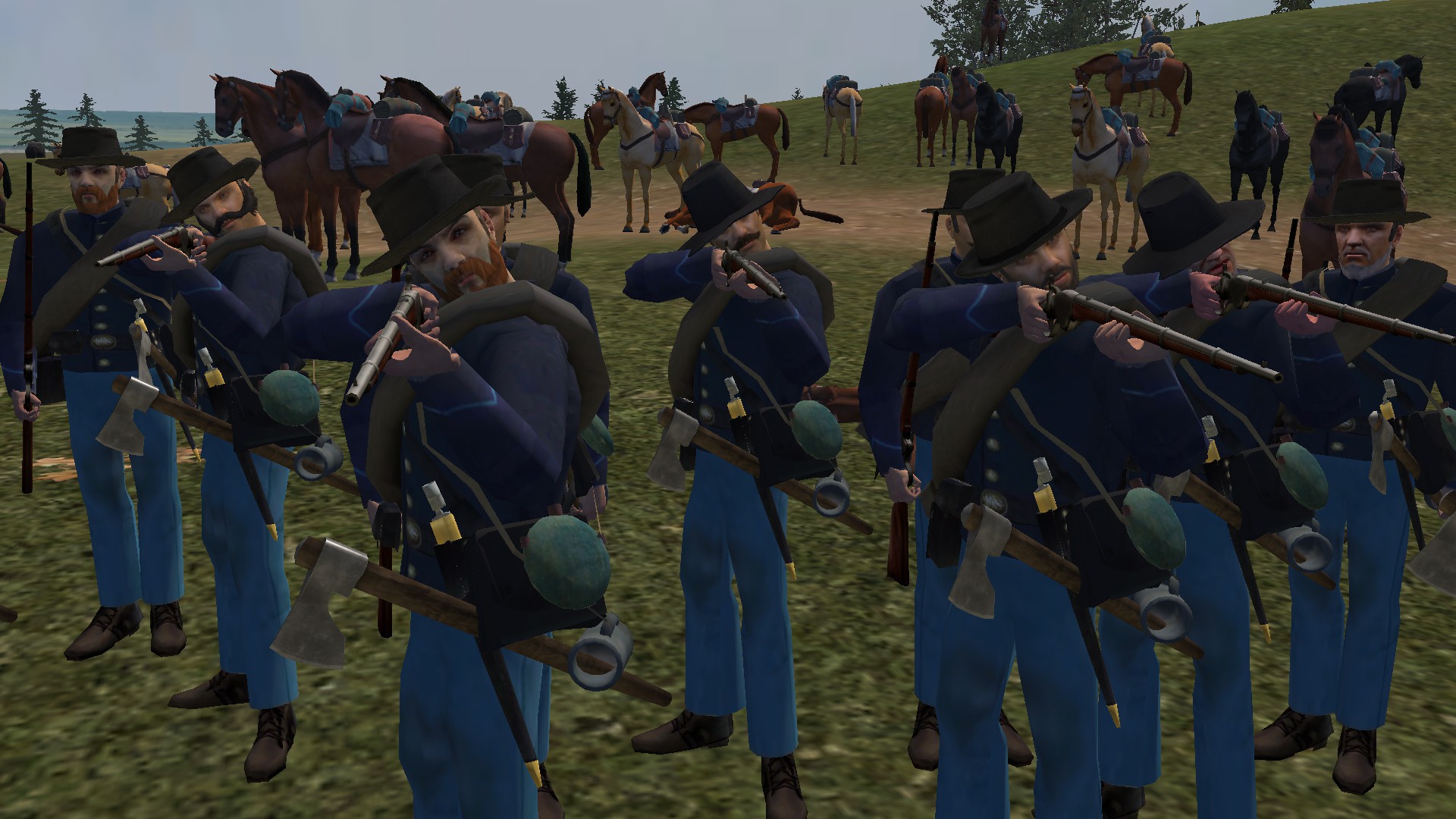
Weapons: Spencer Repeating Rifle, Hatchets
Faction: Army of the Cumberland
Current Commander: Major General George Henry Thomas
Recruitment Locations: Indianapolis, Evansville, Fort Duffield, Owensboro, Bloomington, New Harmony
The Lightning Brigade, made up of the 92nd, 98th and 123rd Illinois, as well as the 17th and 72nd Indiana, was one of the most effective fighting units in the American Civil War, and their audacious and overwhelming early victories sparked the creation of a brand new type of military unit: the mounted infantry.
In early 1863, Wilder's infantry brigade spent several frustrating months trying vainly to stop Confederate General John Hunt Morgan's raids on the Union supply lines. Frustrated both with the enemy and his commanding officers, Wilder asked for, and received permission, to mount his infantry. However, the army still had precious few horses, so attempting a short cut, Wilder procured nearly 1,000 mules from the supply trains and tried to saddle break them. The would-be troopers were nearly always bucked off in short order, much to the amusement of the men from other units who would gather to watch. Undaunted, Wilder ordered his men to sweep the Southern pastures and plantations for horses, and were soon properly mounted.
Wilder also decided the standard issue muzzle loading rifle musket was impossible to use on horseback and set out to find the best weapons available. Many cavalry troopers used breechloading carbines, but Wilder didn't like them because their long range accuracy was poor. Bypassing Army red tape, Wilder had asked his men to vote on purchasing Spencer repeating rifles and they agreed unanimously. He obtained a loan from his hometown bank and each man of the brigade co-signed a personal loan of $35 ($713 in 2019) for his rifle. Embarrassed, the Federal government paid for the weapons before the men expended any of their personal money.
In late June, Colonel John T. Wilder's Brigade got their baptism of fire when General William Rosecrans decided to use Wilder's brigade to spearhead the Tullahoma Campaign in Middle Tennessee. On June 24th, the Lightning Brigade seized and held Hoover's Gap. Despite orders from General Joseph J. Reynolds to fall back, Wilder decided to hold his position, defeating repeated attempts to dislodge his force until reinforcements arrived, winning the most significant battle in the Tullahoma Campaign.
Three months later, The Lightning Brigade performed brilliantly again, this time during the Battle of Chickamauga. Just before the start of the battle, Wilder's brigade played a crucial role at Alexander's Bridge on September 18th, 1863, defending the crossing of West Chickamauga Creek and helping to prevent the Confederates from flanking the Union army. On September 20th, the second day of the battle, Wilder's brigade with its superior firepower was one of the few units that was not immediately routed by the Confederate onslaught against the Union right flank. Advancing from its reserve position, the brigade launched a strong counterattack, driving the Confederates around and through what became known as "Bloody Pond". Major General George H. Thomas formally commended Colonel Wilder for his performance at Chickamauga.
Wilder did not directly participate in the main battles for Chattanooga in November, but he led the brigade during much of the Atlanta Campaign in the spring and summer of 1864. Throughout much of 1863 and 1864, Wilder suffered from bouts of dysentery brought on by a case of typhoid fever in 1862. For health reasons, he resigned from the Army in October 1864 and returned home.
U.S. Colored Cavalry
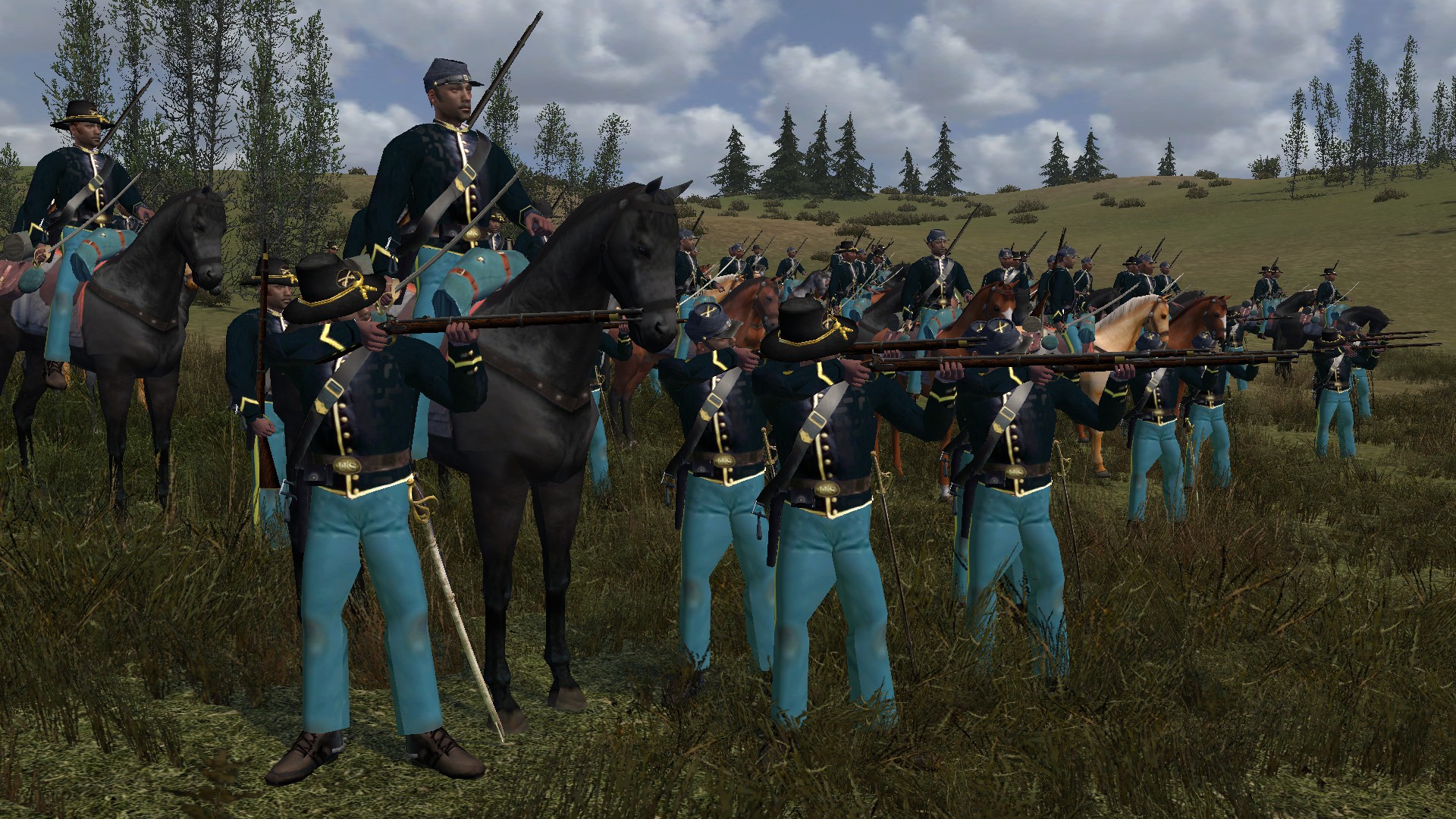
Weapons: Pattern 1853 Enfield Rifle Musket, Sabers
Upgrades to: M1859 Sharps Carbine, Spencer Repeating Carbine, Burnside Carbine, Smith Carbine, Sabers
Faction: Army of the Cumberland
Current Commander: Unassigned (TBA)
Recruitment Locations: Frankfort, Camp Nelson, Lexington, Burkesville, Hodgenville, Camp Dick Robinson, Stamford, Bridgeport
Established in response to a demand for more units from Union Army commanders, by the end of the war in 1865, the 175 total USCT regiments constituted about one-tenth of the manpower of the entire army. The U.S. Colored Cavalry regiments played a significant role during the American Civil War, representing the Union's commitment to utilizing African American soldiers in combat. Formed after the Emancipation Proclamation in 1863, these regiments consisted of freed slaves and free African American volunteers. Initially facing skepticism about their combat abilities, the U.S. Colored Cavalry quickly proved their worth on the battlefield, displaying courage and skill in various engagements. Despite facing discrimination and unequal treatment, these soldiers contributed significantly to the Union's success, challenging racial prejudices prevalent during that era.
The U.S. Colored Cavalry participated in key battles such as the Battle of Saltville and the Battle of Nashville, where they demonstrated their bravery and resilience. Their involvement helped to dispel doubts about the combat effectiveness of African American troops and paved the way for greater acceptance and recognition. After the war, the Colored Cavalry regiments, along with other USCT regiments, played a prominent role on the American frontier in clashes with Native Americans, and came to be known as "Buffalo Soldiers". The struggle for racial equality continued long after the war, but the legacy of the USCT, including the Colored Cavalry, contributed to the broader movement towards civil rights, and paved the way for future integration of the military.
It should be noted that in the mod, the U.S. Colored Cavalry will start off being equipped with Pattern 1853 Enfield rifle muskets, and not every trooper will have a horse. This is to reflect the haste to equip and deploy these units, which was historically the case in particular for the 5th U.S. Colored Cavalry. Therefore these troops are best used as mounted infantry, where their horses are used solely for transportation, and the troopers dismount to engage the enemy on foot. However once they are upgraded to the veteran tier, all of the troopers will have horses, and be equipped with modern cavalry carbines, including Spencers, and can then perform the same role as other cavalry units.
